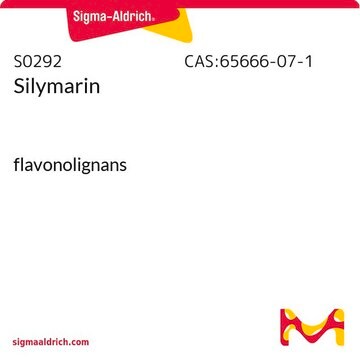Wichtige Dokumente
C7744
Combretastatin A4
≥98% (HPLC), powder
Synonym(e):
1-(3,4,5-Trimethoxyphenyl)-2-(3′-hydroxy-4′-methoxyphenyl) ethane 3,4,5-trimethoxy-3′-hydroxy-4′-methoxystilbene, 2-Methoxy-5-[(1Z)-2-(3,4,5-trimethoxyphenyl)ethenyl]phenol, CA4
Größe auswählen
Größe auswählen
About This Item
Empfohlene Produkte
Assay
≥98% (HPLC)
Form
powder
Farbe
off-white
Löslichkeit
DMSO: >10 mg/mL
Lagertemp.
−20°C
SMILES String
COc1ccc(\C=C/c2cc(OC)c(OC)c(OC)c2)cc1O
InChI
1S/C18H20O5/c1-20-15-8-7-12(9-14(15)19)5-6-13-10-16(21-2)18(23-4)17(11-13)22-3/h5-11,19H,1-4H3/b6-5-
InChIKey
HVXBOLULGPECHP-WAYWQWQTSA-N
Allgemeine Beschreibung
Anwendung
- as an anti-tubulin agent to determine the effects of isocitrate dehydrogenases (IDH1 and IDH2) proteins in G2/M phase[2]
- to evaluate the anti-proliferative and pro-apoptotic properties of biphenyl CA4 derivatives in both 2D and 3D cancerous and non-cancerous cell models[1]
- as a microtubule inhibitor to study its effects on motility of Ascaris suum L3 larvae[3]
Biochem./physiol. Wirkung
Signalwort
Danger
H-Sätze
Gefahreneinstufungen
Acute Tox. 3 Dermal - Acute Tox. 3 Inhalation - Acute Tox. 3 Oral - Eye Dam. 1
Lagerklassenschlüssel
6.1C - Combustible acute toxic Cat.3 / toxic compounds or compounds which causing chronic effects
WGK
WGK 2
Flammpunkt (°F)
Not applicable
Flammpunkt (°C)
Not applicable
Persönliche Schutzausrüstung
Eyeshields, Faceshields, Gloves, type P2 (EN 143) respirator cartridges
Hier finden Sie alle aktuellen Versionen:
Analysenzertifikate (COA)
Die passende Version wird nicht angezeigt?
Wenn Sie eine bestimmte Version benötigen, können Sie anhand der Lot- oder Chargennummer nach einem spezifischen Zertifikat suchen.
Besitzen Sie dieses Produkt bereits?
In der Dokumentenbibliothek finden Sie die Dokumentation zu den Produkten, die Sie kürzlich erworben haben.
Kunden haben sich ebenfalls angesehen
Active Filters
Unser Team von Wissenschaftlern verfügt über Erfahrung in allen Forschungsbereichen einschließlich Life Science, Materialwissenschaften, chemischer Synthese, Chromatographie, Analytik und vielen mehr..
Setzen Sie sich mit dem technischen Dienst in Verbindung.












